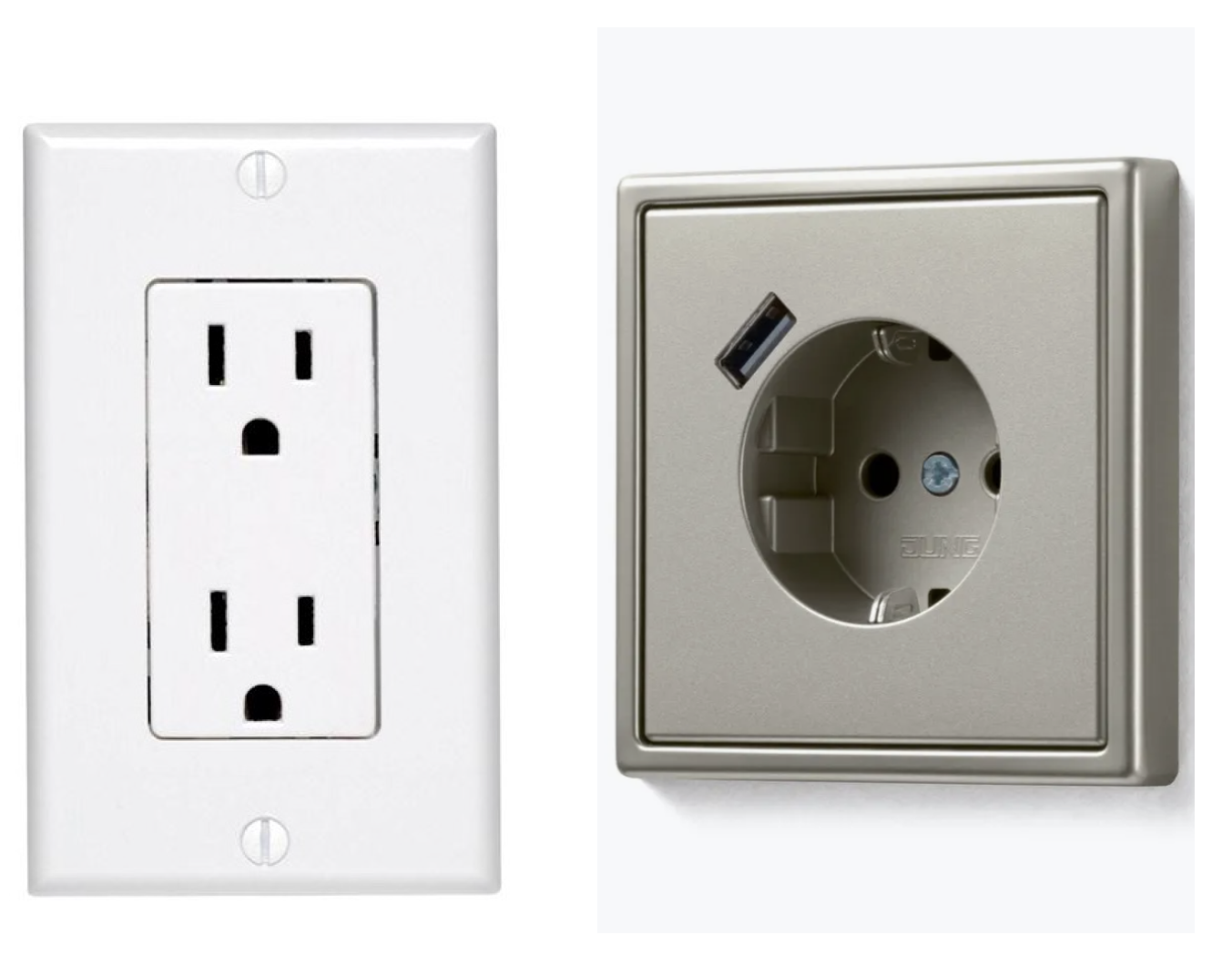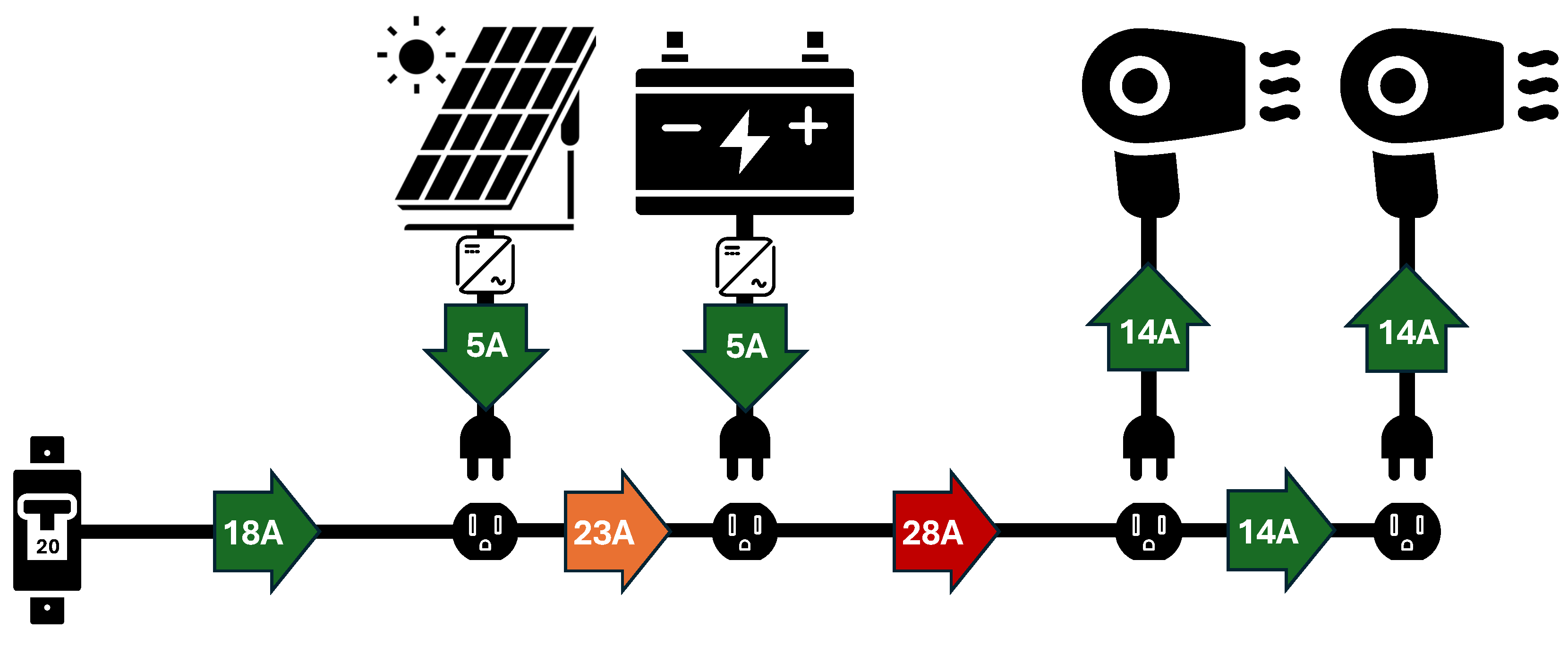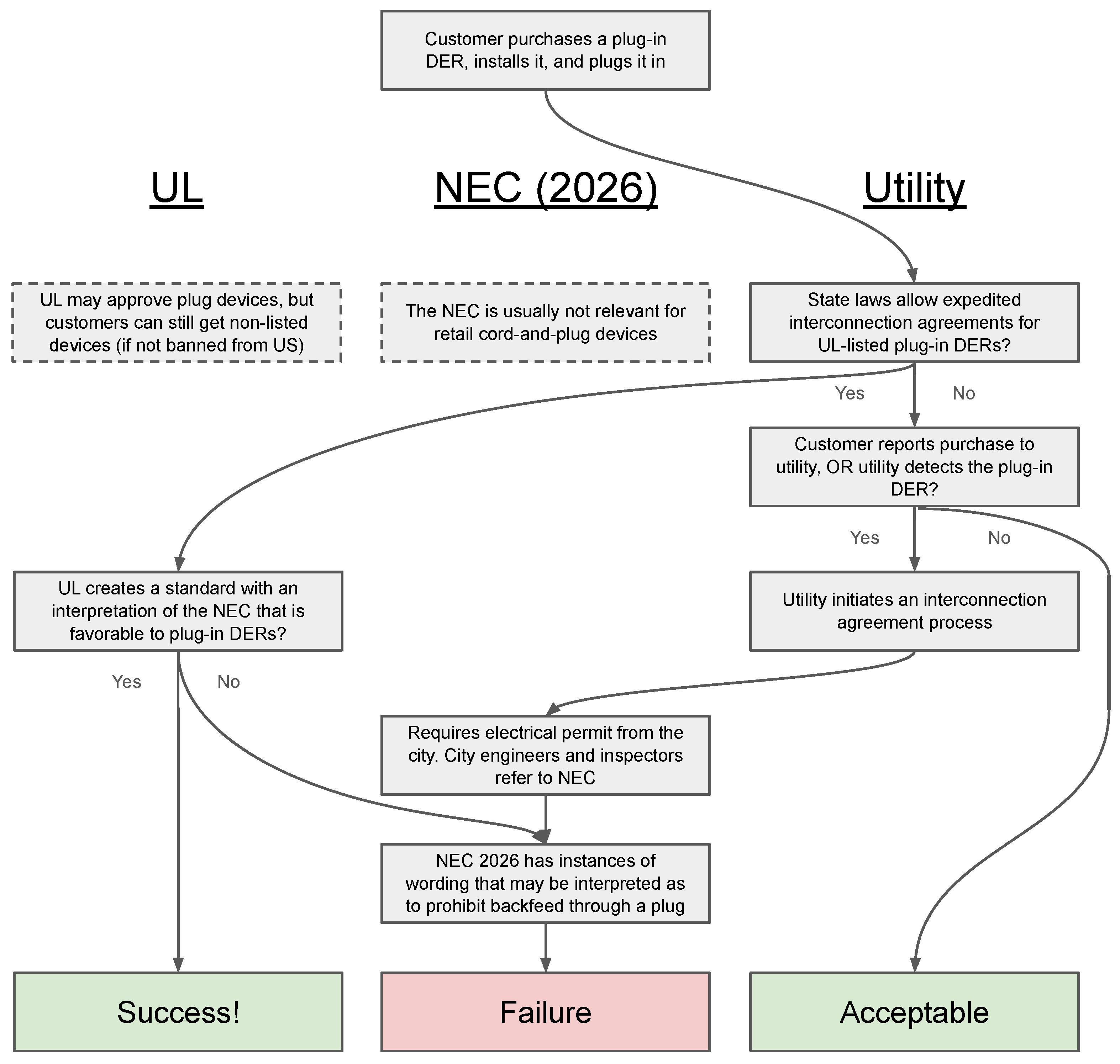Barriers to Balcony Solar and Plug-In Distributed Energy Resources in the United States
Abstract
1. Introduction
1.1. Background and Motivation for Plug-In Distributed Energy Resources
1.2. Adoption of Plug-In DERs
1.3. Scope, Contributions, and Overview of Paper
- Identifying key technical barriers that could pose safety risks if left unaddressed;
- Outlining utility concerns, interconnection challenges, and potential mitigation strategies;
- Detailing regulatory hurdles, including relevant testing standards and restrictive building codes.
- Plug-in solar company—Zoltux;
- Plug-in solar/storage company—Craftstrom;
- Plug-in solar carport company—GismoPower;
- Plug-in battery company—Mana Energy;
- Battery-integrated cooktop company—Impulse Labs;
- Non-export solar/storage company—Raya Power;
- Electrical safety officer—Lawrence Berkeley National Laboratory;
- German industry consultant—Empower Source;
- Nonprofit installer—Brightsaver;
- Eastern utility—Dominion Energy;
- Western utility—(anonymous);
- Underwriter Laboratories (UL).
2. Technical Barriers to Adoption of Plug-In DERs
- Touch-safe plugs;
- Breaker masking;
- Bidirectional GFCIs.
2.1. Touch-Safe Plugs
2.2. Breaker Masking
2.3. Bidirectional GFCIs
3. Utility Interconnection Barriers to Adoption
- Zero export;
- Device registration;
- State legislation;
- Interstate regulation.
3.1. Zero Export
3.2. Device Registration
3.3. State Legislation
3.4. Interstate Regulation
4. Regulatory Barriers to Adoption for Plug-In DERs
- Underwriter Laboratories (UL) Standards;
- National Electrical Code (NEC);
- International Residential Code (IRC).
4.1. UL Standards
- UL 1741—Inverters, Converters, Controllers and Interconnection System Equipment for Use With Distributed Energy Resources. This standard outlines requirements for all inverters, including those integrated into plug-in DERs. It includes rapid shut-off requirements in Supplement B, and upcoming requirements for movable inverters and bidirectional vehicle chargers in Supplement C. UL 1741 might need to be updated with provisions for flexible cord and plug connections.
- UL 943—Ground-Fault Circuit-Interrupters. This standard outlines the technical and testing requirements for GFCIs, and will need to be updated with guidelines for testing and marking bidirectional GFCI breakers and outlets.
- UL 3141—Power Control Systems. This standard is relevant to plug-in DERs that involve meters and utility export control. Zero-export systems can be listed under this standard.
- UL 3741—ANSI/CAN/UL Photovoltaic Hazard Control. This standard outlines rapid shutdown requirements for the DC side of a PV inverter. While rapid shutdown is typically required for rooftop solar to ensure firefighter safety, its necessity for balcony solar is yet to be determined.
- UL 9540—Energy Storage Systems (ESS) and Equipment. This system-level listing applies only to stationary energy storage systems like the Powerwall. However, the IRC and NEC currently classify any battery-containing device as an ESS, imposing strict usage restrictions. Thus, plug-in DERs with storage must avoid UL 9540 as their system-level listing.
- UL 1973—Batteries for Use in Stationary and Motive Auxiliary Power Applications. This is an alternative system-level standard for stationary battery products that would not classify them as an ESS.
- UL 858—Household Electric Ranges. This system-level standard defines requirements and testing procedures for stoves, ovens, and ranges. The proposed Supplement C would permit these appliances to include a battery and allow their classification as appliances rather than ESSs under the NEC and IRC.
- UL 2595—General Requirements for Battery-Powered Appliances. This standard will be referenced in the proposed UL 858 SC, and is completely detached from UL 9540.
- UL 9741—Electric Vehicle Power Export Equipment (EVPE). This system-level listing is necessary for bidirectional EV chargers. It currently requires a hardwired connection, thus disqualifying the bidirectional charging of a plug-in DER.
- UL 414—Meter Sockets. A standard for meter sockets, which is one of the first to allow plug-in DERs.
4.2. National Electrical Code
4.3. International Residential Code
5. Conclusions and Future Work
Author Contributions
Funding
Data Availability Statement
Acknowledgments
Conflicts of Interest
References
- Wood Mackenzie. New NEM 3.0 Provisions ‘Will Cut California Solar Market in Half by 2024’. Available online: https://www.woodmac.com/press-releases/nem-3.0-pd-will-cut-california-solar-market-in-half-by-2024/ (accessed on 5 March 2025).
- Feldman, D.; Zuboy, J.; Dummit, K.; Stright, D.; Heine, M.; Mirletz, H.; Margolis, R. Winter 2024 Solar Industry Update; Technical Report; National Renewable Energy Laboratory (NREL): Golden, CO, USA, 2024.
- Lithium-Ion Battery Pack Prices Rise for First Time to an Average of $151/kWh. BloombergNEF. Available online: https://about.bnef.com/blog/lithium-ion-battery-pack-prices-rise-for-first-time-to-anaverage-of-151-kwh/ (accessed on 9 February 2023).
- California Public Utilities Commission. Decision Adopting Net Energy Metering Successor Program and Tariff. 2022. Available online: https://www.cpuc.ca.gov/industries-and-topics/electrical-energy/renewable-energy/Net-Energy-Metering (accessed on 5 March 2025).
- California Solar & Storage Association. Impact of NEM-3 on California’s Renewable Energy Progress and Solar Jobs; Technical Report; California Solar & Storage Association: Sacramento, CA, USA, 2023. [Google Scholar]
- Hammerle, M.; White, L.V.; Sturmberg, B. Solar for renters: Investigating investor perspectives of barriers and policies. Energy Policy 2023, 174, 113417. [Google Scholar] [CrossRef]
- Keslinke, A.G. Cocreating Property Value and Energy Justice: A Framework to Leverage Investor Self-Interest to Overcome the Renewable Energy Split-Incentive in Rental Property. Master’s Thesis, Harvard University, Cambridge, MA, USA, 2024. [Google Scholar]
- Ramasamy, V.; Zuboy, J.; Woodhouse, M.; O’Shaughnessy, E.; Feldman, D.; Desai, J.; Walker, A.; Margolis, R.; Basore, P. Us Solar Photovoltaic System and Energy Storage Cost Benchmarks, with Minimum Sustainable Price Analysis: Q1 2023; Technical Report; National Renewable Energy Laboratory (NREL): Golden, CO, USA, 2023.
- Gerber, D.L.; Nordman, B.; Brown, R.; Poon, J. Cost analysis of distributed storage in AC and DC microgrids. Appl. Energy 2023, 344, 121218. [Google Scholar] [CrossRef]
- European Commission. Photovoltaic Geographical Information System (PVGIS). 2025. Available online: https://ec.europa.eu/jrc/en/pvgis (accessed on 5 March 2025).
- Plugin Solar. Available online: https://plugin-solar.eu/ (accessed on 5 March 2025).
- Seme, S.; Strojanšek, L.; Simonič, E.; Sredenšek, K. Balcony Solar Photovoltaic Plug-And-Play Systems. Available online: https://www.icrepq.com/icrepq24/422-24-seme.pdf (accessed on 13 March 2025).
- Mundada, A.S.; Prehoda, E.W.; Pearce, J.M. US market for solar photovoltaic plug-and-play systems. Renew. Energy 2017, 103, 255–264. [Google Scholar] [CrossRef]
- The Guardian. ‘If 1.5 m Germans Have Them There Must Be Something in It’: How Balcony Solar Is Taking Off. 2024. Available online: https://www.theguardian.com/environment/2024/dec/18/if-a-million-germans-have-them-there-must-be-something-in-it-how-balcony-solar-is-taking-off (accessed on 6 March 2025).
- Hanley, S. Germany Embraces Balkonkraftwerke—Balcony Solar For Apartments—CleanTechnica. 2024. Available online: https://cleantechnica.com/2024/12/21/germany-embraces-balkonkraftwerke-balcony-solar-for-apartments/ (accessed on 6 March 2025).
- VDE V 0100-551-1; Low-Voltage Electrical Installations—Part 5-51: Selection and Erection of Electrical Equipment—Common Rules. VDE Verlag: Berlin, Germany, 2023.
- VDE-AR-N 4105:2018-11; Technical Requirements for the Connection and Operation of Customer Installations to the Low Voltage Network. VDE–Verband der Elektrotechnik Elektronik Informationstechnik e.V.: Berlin, Germany, 2018.
- Erge, T.; Laukamp, H.; Diazgranados, L.M.; Armbruster, A.; Fischer, D. Steckerfertige, Netzgekoppelte Kleinst-PV-Anlagen: Studie für E-Control Austria; Technical Report; Fraunhofer-Institut für Solare Energiesysteme ISE: Freiburg im Breisgau, Germany, 2016. [Google Scholar]
- European Commission. Commission Regulation (EU) 2016/631 of 14 April 2016 Establishing a Network Code on Requirements for Generators. Off. J. Eur. Union 2016, L 112, 1–68. Available online: https://eur-lex.europa.eu/legal-content/EN/TXT/?uri=CELEX%3A32016R0631 (accessed on 7 March 2025).
- SolarPower Europe. Plug-In Solar PV: Solar for All—A Deep-Dive on a Fast-Emerging PV Segment; Technical Report; SolarPower Europe: Brussels, Belgium, 2025. [Google Scholar]
- Mundada, A.S.; Nilsiam, Y.; Pearce, J.M. A review of technical requirements for plug-and-play solar photovoltaic microinverter systems in the United States. Sol. Energy 2016, 135, 455–470. [Google Scholar] [CrossRef]
- HB0340. Available online: https://le.utah.gov/~2025/bills/static/HB0340.html (accessed on 6 March 2025).
- Weaver, J.F. Balcony Solar Gains Unanimous Bipartisan Support in Utah—pv Magazine USA, 2025. Available online: https://pv-magazine-usa.com/2025/03/05/balcony-solar-gains-unanimous-bipartisan-support-in-utah/ (accessed on 7 April 2025).
- Jeykishan Kumar, K. Automated Disconnection Time for Inverter Island Testing. Available online: https://dewesoft.com/blog/automated-disconnection-time-for-inverter-island-testing (accessed on 7 March 2025).
- Hoke, A.; Nelson, A.; Miller, B.; Chakraborty, S.; Bell, F.; McCarty, M. Experimental Evaluation Oo Pv Inverter Anti-Islanding with Grid Support Functions in Multi-Inverter Island Scenarios; Technical Report; National Renewable Energy Lab. (NREL): Golden, CO, USA, 2016.
- Ellis, A.; Gonzalez, S.; Miyamoto, Y.; Ropp, M.; Schutz, D.; Sato, T. Comparative analysis of anti-islanding requirements and test procedures in the United States and Japan. In Proceedings of the 2013 IEEE 39th Photovoltaic Specialists Conference (PVSC), Tampa, FL, USA, 16–21 June 2013; IEEE: Piscataway, NJ, USA, 2013; pp. 3134–3140. [Google Scholar]
- Individual Test Method of Grid-connected Protective Equipment etc., for Multi-Unit Grid-Xonnected PV Power Generating Systems; Technical Report JETGR0003-4-1.0; Japan Electrical Safety & Environment Technology Laboratories (JET): Tokyo, Japan, 2011. (In Japanese)
- Underwriters Laboratories. UL 943. Standard for Ground-Fault Circuit Interrupters; Underwriters Laboratories: Northbrook, IL, USA, 2017.
- National Fire Protection Association (NFPA). NFPA 70: National Electrical Code (NEC), 2023 ed.; National Fire Protection Association: Quincy, MA, USA, 2023. [Google Scholar]
- Ye, K.; Kim, H.; Lu, N. Mobile Electric Generating Appliance (MEGA) Impact Analysis, 2023. Available online: https://drive.google.com/file/d/1xeYstAGyeK_6htZRUaLdWus5Uo–vofE/view?usp=sharing (accessed on 10 March 2025).
- Teyber, A.; Cezar, G.V. Gismo Power Impact Analysis, 2025. Available online: https://drive.google.com/file/d/1WAno_YiIrHRt_LD5md3Oz_url8VLJpW7/view?usp=sharing (accessed on 10 March 2025).
- MaStR. Welcome to the Market Data Register. Available online: https://www.marktstammdatenregister.de/MaStR (accessed on 12 March 2025).
- Zurie, Q. Germany’s Simplified Balcony Solar System Registration Process Explain—SUNSHARE. 2024. Available online: https://sunsharetek.com/blogs/government-policies/germany-s-simplified-balcony-solar-system-registration-process-explained (accessed on 12 March 2025).
- Federal Energy Regulatory Commission. Participation of Distributed Energy Resource Aggregations in Markets Operated by Regional Transmission Organizations and Independent System Operators. 2020. Available online: https://www.federalregister.gov/documents/2021/03/30/2021-06089/participation-of-distributed-energy-resource-aggregations-in-markets-operated-by-regional (accessed on 17 March 2025).
- Federal Energy Regulatory Commission. FERC Order No. 2222: Fact Sheet. Available online: https://www.ferc.gov/media/ferc-order-no-2222-fact-sheet (accessed on 17 March 2025).
- Electricity Advisory Committee. FERC Order 2222 Recommendations for the U.S. Department of Energy—Outline. 2021. Available online: https://www.energy.gov/sites/default/files/2021-04EAC%20FERC%20Order%202222%20Recommendations%202021-04-15_finalDraft.pdf (accessed on 19 March 2025).
- Federal Energy Regulatory Commission. Order No. 2023-A: Revisions to Generator Interconnection Procedures and Agreements. 2024. Available online: https://www.ferc.gov/electric-transmission/generator-interconnection/final-rules-establishing-and-revising-standard (accessed on 17 March 2025).
- Federal Energy Regulatory Commission. Explainer on the Interconnection Final Rule. Available online: https://www.ferc.gov/explainer-interconnection-final-rule (accessed on 17 March 2025).
- IEEE USA Board of Directors. Testing Reciprocity by National Recognized Testing Laboratories (NRTLs). Available online: https://globalpolicy.ieee.org/wp-content/uploads/2018/03/IEEE18004.pdf (accessed on 17 March 2025).
- Ginsberg-Klemmt, A. Research Performance Progress Report 1: The MEGA: Cost-Effective Plug-in Portable Solar Electricity for Lower to-Moderate Income Homes and Small Businesses; Technical Report DE-SC0022708; U.S. Department of Energy: Washington, DC, USA, 2023.
- International Code Council. 2021 International Residential Code for One- and Two-Family Dwellings; International Code Council: Washington, DC, USA, 2021. [Google Scholar]
- International Code Council. 2021 International Fire Code; International Code Council: Washington, DC, USA, 2021. [Google Scholar]








Disclaimer/Publisher’s Note: The statements, opinions and data contained in all publications are solely those of the individual author(s) and contributor(s) and not of MDPI and/or the editor(s). MDPI and/or the editor(s) disclaim responsibility for any injury to people or property resulting from any ideas, methods, instructions or products referred to in the content. |
© 2025 by the authors. Licensee MDPI, Basel, Switzerland. This article is an open access article distributed under the terms and conditions of the Creative Commons Attribution (CC BY) license (https://creativecommons.org/licenses/by/4.0/).
Share and Cite
Gerber, D.L.; Ginsberg-Klemmt, A.; Stoler, L.; Shackelford, J.; Meier, A. Barriers to Balcony Solar and Plug-In Distributed Energy Resources in the United States. Energies 2025, 18, 2132. https://doi.org/10.3390/en18082132
Gerber DL, Ginsberg-Klemmt A, Stoler L, Shackelford J, Meier A. Barriers to Balcony Solar and Plug-In Distributed Energy Resources in the United States. Energies. 2025; 18(8):2132. https://doi.org/10.3390/en18082132
Chicago/Turabian StyleGerber, Daniel L., Achim Ginsberg-Klemmt, Lyn Stoler, Jordan Shackelford, and Alan Meier. 2025. "Barriers to Balcony Solar and Plug-In Distributed Energy Resources in the United States" Energies 18, no. 8: 2132. https://doi.org/10.3390/en18082132
APA StyleGerber, D. L., Ginsberg-Klemmt, A., Stoler, L., Shackelford, J., & Meier, A. (2025). Barriers to Balcony Solar and Plug-In Distributed Energy Resources in the United States. Energies, 18(8), 2132. https://doi.org/10.3390/en18082132







